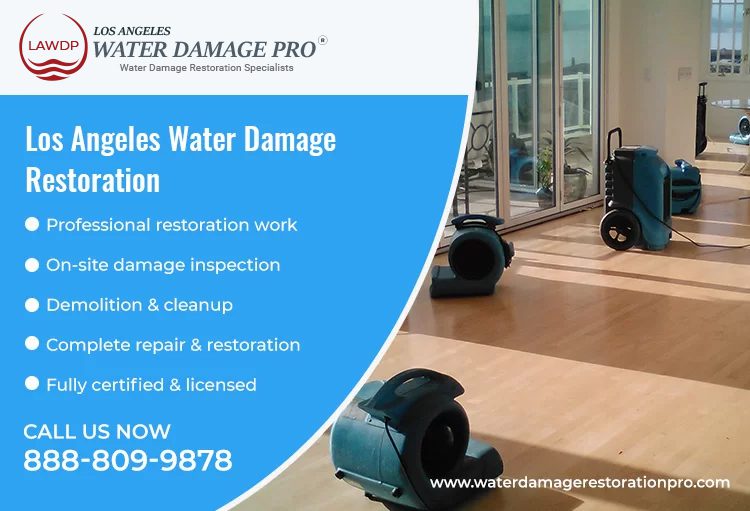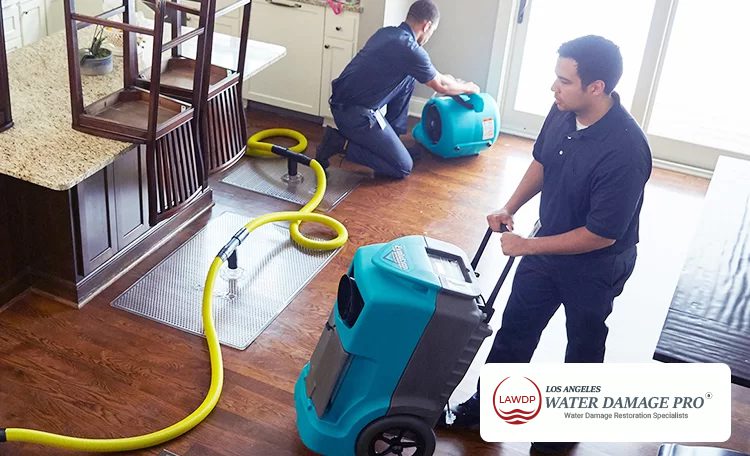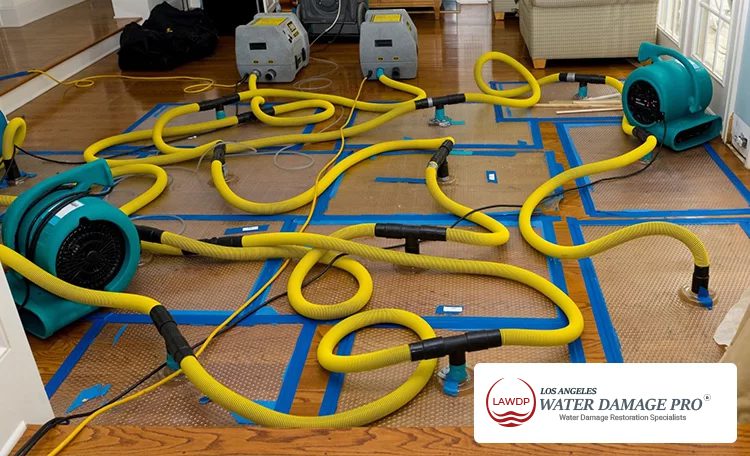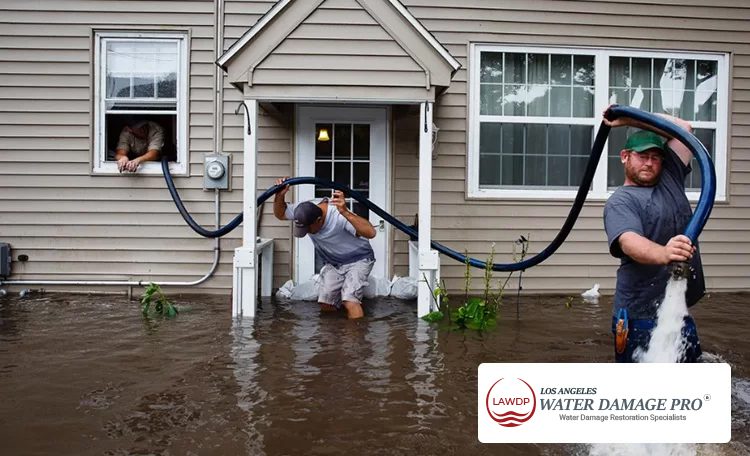- 24/7 Water Damage Emergency
- Licensed and Insured
- FREE Estimates
- Direct Insurance Billing
- Insurance Claims
Have you noticed that a puddle of water has formed in your kitchen? Do your ceiling and walls leak water? It can be challenging to find the source of water damage, as it can originate from multiple locations. But, one thing is for sure: one or more structures in your home were damaged.
Water damage can come from outside or inside. Water damage from the exterior is primarily caused by flood water entering your home due to dilapidated house structures that are no longer able to function properly. Some examples include:

Meanwhile, indoor water damage typically stems from leaks and cracks in your appliances, fixtures, and systems, such as:
Since you regularly use most of these parts of your home, it should be easier for you to spot these problems. Once you notice the smallest signs of water damage in your home, don’t hesitate to call the closest water damage restoration company to your location.
How can restoration be started without having any meaningful information about water damage? To assess the severity of water damage, the International Cleaning and Restoration Certification Institute (ICCRC) established three categories of water damage:
The water comes from sanitary, potable sources, suitable for human use and consumption. These sources can include compromised sprinkler systems, damaged supply lines, and rain.
The second category refers to sources with significant biological and chemical contamination, potentially causing nuisance and illness.
Finally, this category of water damage is characterized by unacceptable and highly polluted water containing toxic agents and pathogens.
Basically, these categories determine how polluted the water is. Separating them into categories allows for better sewage cleanup, flood damage repair, and water mitigation.
Water damage can escalate to a higher category if not resolved quickly; increasing the consequences you can suffer.
It is important to act quickly when your home is damaged by water. Here is the timeline of the damage caused by water
| Time Since Water Damage | Effects |
| Within minutes | Water spreads quickly, saturating everything it comes in contact with. Damages paper and other sensitive material |
| Within hours | Water absorption causes swelling and warping of wood, furniture, and upholstery. Paper goods and documents become damp and begin to deteriorate. |
| Within 24-48 hours | Mold and mildew growth begins. Drywall and other porous materials start to disintegrate. Dyes and inks from fabrics and paper goods start to run and stain. |
| Within 1 week | Structural damage becomes more severe. Wood studs and framing can begin to warp and split. Metal surfaces begin to rust and corrode. |
| After 1 week | Mold and mildew growth becomes more widespread and severe. Structural damage becomes more extensive, and the risk of collapse increases. The potential for long-term health hazards from mold exposure becomes a serious concern. |
Take note of these instructions for restoring your home after water damage. This guide applies to the most common water damage scenarios, from natural disasters to faulty appliances.
First of all, recognize that you are working in a wet environment, which is a significant electrical hazard. Before entering the wet area or touching any wet structure, check for any electrical damage. Much better, turn off all electrical and gas systems. Watch for structural damage too.
Plus, keep your other household items safe with these tips:
If you’ve been experiencing continuing water damage, such as long-term flooding, or you’ve just discovered your sink is leaking, chances are the fixtures and other structures are soaked with water. Some of them may still recover, but it is the best time to say goodbye to completely ruined structures.
Check out these tips for each structure:
Subfloor
Submerged oriented strand board (OSB) and plywood are more likely to swell and separate. Damaged parts must be replaced.
Wooden Floors
Carefully remove each board to prevent bending. The floor must be cleaned and dried before repairs and replacements.
Tile and sheet floors
If the floor is concrete, it is best to dry it as it is. If water has entered loose flooring sheets, remove and dry.
Painted walls, floors, and woodwork
Mold can easily spread on wet, damp surfaces, so make cleaning and drying a priority as soon as possible. You can use dehumidifiers, heaters, fans, or desiccants to speed up drying.
Furniture
Take out your furniture and remove mud and dirt first. Furniture with drawers and containers must be removed and cleaned individually. Use the proper commercial cleaning products to clean your furniture.
Equipment and appliances
Take extra time to check and make sure your equipment and appliances are completely dried and that no components are compromised. If you are not sure, it would be better to seek professional help.
Now that your structures have completely dried out, it’s time to plan for repairs and replacements of all damaged parts.
For the most part, water damage to property is pretty obvious. If the excess water is coming from something like a broken pipe or basement flooding, you will be able to see the water and all the damage it is causing. But sometimes this is not always the case. And water damage can surprise you when you least expect it.
Maybe you have a slow leaking appliance pipe that is hidden or a roof leak that is out of sight. As unwanted water seeps into your home or office, you may not realize the damage it’s causing. Also, the damage that can be caused by water may not always be obvious to the eye, but hidden behind walls or under baseboards.
However, if this does happen, there are a few signs you can look out for that can help you spot if you do in fact have water damage. Below, we take a look at these signs and how to identify if your property is experiencing water damage.

One of the first signs of water damage is a mold infestation. If you can see the telltale sign of a mold patch, consider yourself lucky.
But sometimes mold settles in hidden places, between drywall or under floorboards, making it hard to find.
If there is a leak lurking behind a wall, you may notice some changes in the surface of the wall. The paint or wallpaper will begin to blister and bubble, and may even begin to peel and crack if the water damage progresses.
If this happens, it usually means the wall has been exposed to excess water, causing the building materials to shrink and expand. This contraction and expansion cause the paint to weaken, causing it to peel and eventually crack.
Another telltale sign of water damage is evident on the flooring in your property. If water collects in or under the floor, you may start to notice that your wood or laminate flooring begins to warp, or that grouted tiles loosen and begin to shift slightly. Check your subfloor for leaks before water starts seeping through the floorboards or tiles.
If you find a puddle of water somewhere in your home or office, clean it up, keep an eye on it for a few days, and see if the puddle comes back.
Normally, if something drips or leaks, a puddle of water will form on the floor. You might be dealing with a leak or seepage if the dreaded pool or puddle reappears.
If your space is very difficult to heat in the colder months, this could be a sign that you have moisture inside the walls of your property.
This excess moisture sometimes draws heat away from the walls, and as a result, leaves them much cooler than if no moisture were present.
So if you can’t seem to heat your home or commercial facility, no matter how high you turn up the heat, it might be time to check your walls for leaks or moisture buildup.
While you can see and smell water damage, don’t forget that you can also hear it. Not surprisingly, if you can hear dripping or running water, you likely have a leak.
Sure, water flows, gushes, and drips through pipes every day, but keep an eye out for new or changed noises that aren’t included in the normal sounds.
Dirty water often leaves streaks as it runs down the walls of your property. If you see brown streaks forming on the sides of your exterior, this can sometimes be a sign of an overflowing gutter or your roof not draining properly.
Your gutters could be blocked with leaves and debris, so you better get them checked out before you have a problem on your hands.
If you suspect water damage to your home or commercial property, your best option is to call in professionals to provide water damage restoration in Los Angeles.
The longer you postpone dewatering and water remediation, the cost of restoration and the risk of permanent damage and mold growth increases.
Health and safety should be the top priority at all times when undertaking the Los Angeles water damage restoration process. Each category of water damage carries specific health and safety risks that require specific precautions.
This can range from something as simple as properly ventilating the area to wearing full protective gear.
There are safety measures that must be taken, regardless of the type of water damage.

OSHA has clear guidelines and standards for proper health and safety precautions. They have established regulations that dictate how much exposure any worker can have to hazardous materials and circumstances.
They identify substances and materials that could pose a threat and describe how they should be addressed. These procedures include the bagging, transportation, and treatment of hazardous materials, along with the equipment to be used.
Any worker who restores buildings after water damage has proper training and education in restoration techniques and health and safety. This includes any hazards in the surrounding environment that are possible while performing your duties. They are also fully trained in OSHA rules and regulations on water damage restoration in Los Angeles, as well as local and state requirements.
To ensure the health of your family or employees, it is important to quickly dry out the water-damaged area, using professional water damage restoration equipment. The following equipment are usually used:
Moisture sensors and gauges
These help technicians know how wet an area is and how they will need to restore it. They show the moisture content of floors, ceilings, walls, and other materials.
Air movers
Air movers will blow air across surfaces and help dry the space quickly and efficiently. There are various sizes, the largest being the most powerful, moving more air per minute.
Dehumidifiers
They will extract the water from the air and drain it so that it does not redeposit on the materials. A standard unit can remove approximately 150 pints of water from the air every 24 hours.
Air scrubbers
They work to clean the air by removing chemicals, particles, and/or gases from the air by pushing them through filters.
This is very helpful when it comes to fire damage restoration. With water damage, they help eliminate odors associated with mold and mildew. Wet air scrubbers use a wet filter to trap airborne particles. Dry air scrubbers have an ionic purifier to perform a similar function.
Foggers
They turn a chemical into a mist to remove odors and kill bacteria. Thermal foggers heat and blast into a space a deodorizer with a solvent base. The solution sticks to the molecules and absorbs them.
Generators
These will provide power for all technical equipment if there is a power loss.
When it comes to water removal and restoration, there is a lot to know and a lot to consider. When a situation involves flooding and possible contamination, it’s best to leave the job to the professionals.
Contractors and water extraction and restoration companies must have the proper training and tools to do the job safely and effectively.
They must be fully trained not only in the water damage repair process but also in all health and safety measures.
| Leaking pipe restoration | Fixing the leaking drainage pipes in kitchen & bath |
| Flood damage restoration | Repairing the floor, wall tiles and other fixtures |
| Paint damage restoration | Full interior & exterior repainting of walls |
| Mold damage restoration | Treating the mold, moss & mildew after water drying |
Water damage is one of the most common and costly disasters your home can experience, costing billions of dollars a year. Protect your most important asset from water damage with the right insurance coverage and the following tips.

Basement water is often caused by cracks in building foundations or floor slabs. If you notice a leak after heavy rain when you’ve never had a problem, it may mean that your once-waterproof concrete floors and basement walls have deteriorated. Painting vulnerable areas with water sealant can prevent seepage.
Seepage is aggravated by soil that has settled in such a way that it causes water to flow into the building. After a storm, and especially if the ground is already saturated, rainwater flowing into the building runs down the outside of the foundation wall, potentially through cracks.
Although less common than other causes of water, sewer overflows are tricky. Learn about your sewer responsibilities and install and maintain a check valve, which allows sewage to flow out, but not back in.
Any hoses with leaks or cracks should be changed right away, and you should replace all hoses every five to seven years.
Homes are filled with a complex array of plumbing, electrical wiring, and ventilation systems. However, the only parts we see in our homes every day are the interior walls, the decorations, and our contents. Underneath it all, there are layers of activity that make your house tick.
Without proper maintenance and regular checking of key components in your home, anything could be going wrong below the surface, and you’d never know it until the damage causes structural changes or there is some physical evidence.
Water damage restoration is a difficult and expensive home emergency to tackle, but it will absolutely save you from worse damage and health consequences. Worse yet, your water damage restoration project can be even more difficult to pull off if the damage is severe and has spread to multiple parts of your home.
If you can’t handle the entire restoration project, know that water damage restoration experts are just a phone call away.
At Water Damage Restoration Pro, we have decades of experience in water damage mitigation and restoration. After determining the source of the leak and concentrating on preventing additional damage, our team will provide cleanup and restoration services. Available 24/7, our team will arrive on-site with the best equipment and techniques for water damage repairs in Los Angeles.
Here is an overview of the different steps for water damage restoration, their average costs, and the time it takes:
| STEPS | AVERAGE COSTS | TIME TAKEN |
| Emergency Water Removal | $500 – $10,000 | 1-2 hours |
| Inspection and Damage Assessment | $200 – $500 | 1-2 hours |
| Moisture Detection and Monitoring | $100 – $300 | 1-2 hours |
| Mold Inspection and Removal | $500 – $6,000 | 1-5 days |
| Water Extraction and Drying | $1,000 – $5,000 | 2-5 days |
| Repair and Reconstruction | $2,000 – $20,000 | 1 week – several months |
Please note that these costs and time frames are estimates and can vary depending on the severity and extent of the water damage, as well as the location.
Water causes sagging and deterioration. It causes the wood to swell, warp, and eventually rot. And it permanently ruins fabric items like rugs and furniture that get soaked for more than a couple of days.
Water damage can also be a significant electrical hazard. It can short-circuit electrical systems, leading to fires, electrical shock hazards, and damage to electronic components.
You can clean some of the damage. But first, be sure to take pictures before you do anything. It’s okay to clean up excess water, but if the water has flooded a large area of your home, you’ll need professional services to prevent and repair major damage.
An excessive amount of water will soak into your floors and collect behind your walls, which is a problem homeowners cannot safely solve on their own. These concealed, wet areas are a haven for mildew, mold, and structural degradation. Mold is a serious health threat to everyone who enters the building, and if a structure is deemed unstable, you will not be able to enter.
Yes, in Los Angeles, you need a permit for water damage restoration. The City of Los Angeles requires permits for most construction, repair, or remodeling work, including water damage restoration. The permit process ensures that the work is done safely, up to code, and meets all necessary regulations.
To obtain a permit for water damage restoration, you should contact the Los Angeles Department of Building and Safety (LADBS) and follow their guidelines. Depending on the extent of the damage and the scope of the restoration work, you may need to submit plans, obtain inspections, and pay fees. Our team will guide you through the process.
Prevention of further damage begins with stopping the water source. Then call your insurance company and ask if you have coverage. They will likely issue you a claim and recommend that you call a restoration company.
After calling a professional water damage restoration company and they deem it safe for you to enter, take plenty of pictures.
Take enough photos to document all the damage, then you can move furniture and other items out of the flooded area and try to remove some of the standing water. But don’t throw anything away. A reputable water damage restoration company will quickly arrive to begin countering the damage.
Water damage due to flooding is difficult to prevent. You can, however, take a few safety precautions. You can apply coatings and sealants to your foundation, walls, windows, and doors to help prevent flood water from seeping into your home. All electrical outlets must be at least one foot above the flood level to prevent electrical damage.
To prevent water damage from a flooded sewer system, install valves on the pipes to prevent it from backing up into your home.
Plumbing problems cause the majority of water damage. Regular maintenance and inspections can help you catch most plumbing problems before they cause serious water damage.
If the water damage is severe, and there is extensive damage to the structure or the electrical and plumbing systems, it may be necessary to evacuate the property for safety reasons. Additionally, if there is extensive mold growth, it may be necessary to vacate the property to prevent health hazards. In these cases, your restoration contractor will advise you to move out temporarily, and you should follow their advice.
On the other hand, if the damage is minor, and the restoration work is limited to a specific area of the property, you may be able to stay in your home or business during the restoration work. However, keep in mind that the restoration work may be noisy, dusty, and disruptive to your daily routine. In such cases, you may want to consider moving out temporarily to avoid inconvenience.
Here are some of the different types of equipment commonly used for water damage restoration:
Extractors: Extractors are machines that use suction to remove standing water from floors, carpets, and other surfaces. They are available in different sizes and capacities depending on the severity of the damage.
Dehumidifiers: Dehumidifiers help to reduce the moisture levels in the air and prevent mold growth. They are available in different types and sizes, and some can even be portable.
Air movers: Air movers are high-speed fans that are used to increase air circulation in the affected area, helping to speed up the drying process.
Moisture meters: Moisture meters are used to measure the moisture content in various materials such as walls, floors, and ceilings. This helps to determine if the area is dry and if further restoration is required.
Structural drying equipment: Structural drying equipment such as specialized heaters and dehumidifiers can be used to remove moisture from structural components like walls and floors.
Yes, we offer complete assistance in removing the debris as well. When a property suffers from water damage, it’s not just the water that causes damage, but also the debris and waste that it can bring in. This debris can include damaged furniture, wet carpets, building materials, and other items.